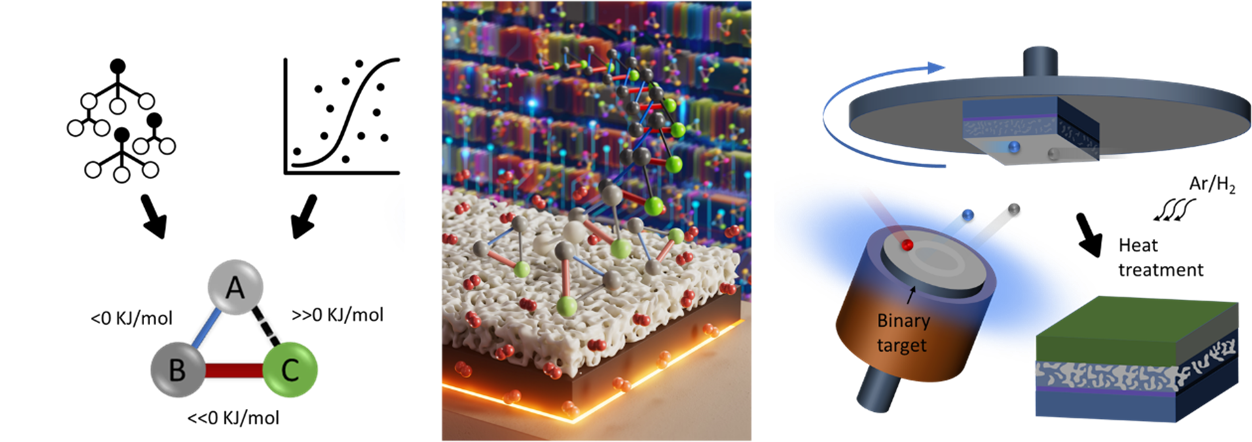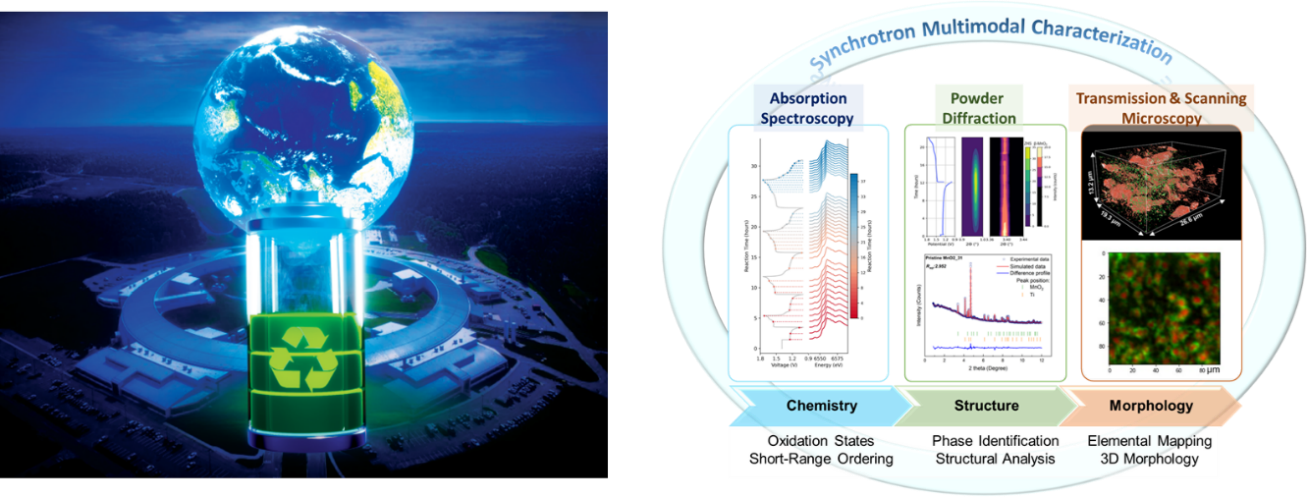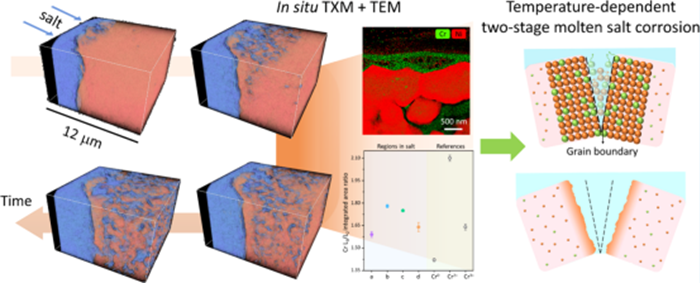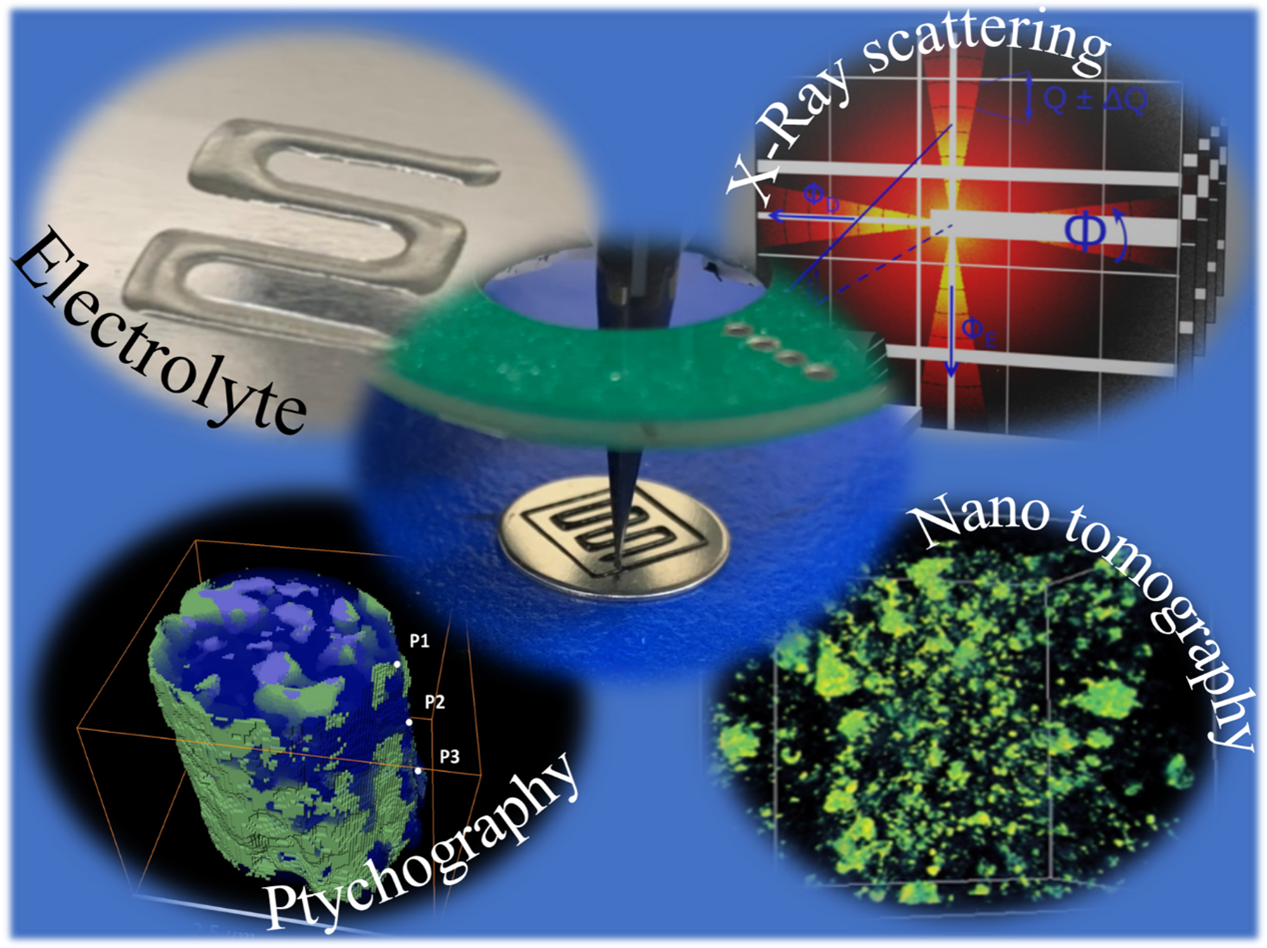Materials Process-Structure-Property Relationship: Functional Porous Metals and Alloys and Bicontinous Metallic Composites
Produced through the innovative process of dealloying, where a parent alloy (alloy AB) separates into A and B components using a dealloying agent (element C), these special metals, alloys, and composites transform into a bicontinuous structure. We have introduced a new method, thin-film solid-state metal dealloying (thin-film SSMD). Using advanced X-ray techniques and electron microscopy, we are delving into their processing-structure-property relationship. We have also incorporated machine learning methods to discover new dealloying materials, refining predictions through synchrotron experiments. Our primary aim is to accelerate the discovery of unique materials with mechanistic understanding for novel applications.

Figure - Design and discovery of the solid-state metal dealloying through the machine-learning method and experimental validation
Publications:
1."Machine-learning for designing nanoarchitectured materials by dealloying"
Chonghang Zhao, Cheng-Chu Chung, Siying Jiang, Marcus M. Noack, Jiun-Han Chen, Kedar
Manandhar, Joshua Lynch, Hui Zhong, Wei Zhu, Phillip Maffettone, Daniel Olds, Masafumi
Fukuto, Ichiro Takeuchi, Sanjit Ghose, Thomas Caswell, Kevin G. Yager & Yu-chen Karen
Chen-Wiegart*
Communications Materials (2022), DOI:10.1038/s43246-022-00303-w
PDFJournal
2. "Kinetics and evolution of solid-state metal dealloying in thin films with multimodal
analysis"
Chonghang Zhao, Lin-Chieh Yu, Kim Kisslinger, Charles Clark, Cheng-Chu Chung, Ruipeng
Li, Masafumi Fukuto, Ming Lu, Jianming Bai, Xiaoyang Liu, Hui Zhong, Mingzhao Liu,
Sanjit Ghose, Yu-chen Karen Chen-Wiegart*
Acta Materialia (2023), DOI:10.1016/j.actamat.2022.118433
PDFJournal
3. "Oxidation Driven Thin-Film Solid-State Metal DealloyingForming Bicontinuous Nanostructures"
Cheng-Chu Chung, Charles Clark, Chonghang Zhao, Kim Kisslinger, Fernando Camino, Dmytro
Nykypanchuk, Hui Zhong, Sanjit Ghose, Ruipeng Li, Chang-Yong Nam and Yu-chen Karen
Chen-Wiegar*
Advanced Materials Interfaces (2023), DOI:10.1002/admi.202300454
PDFJournal
Support:
This material is based on work supported by the National Science Foundation under Grant No. DMR-1752839
Joint Photon Sciences Institute (JPSI) fellowship
Sustainable Energy: Multimodal Studies of Batteries by Advanced Synchrotron X-ray Characterization
In advancing next-generation energy storage technologies, a deep understanding of reaction mechanisms is important. Our research emphasizes various systems, including Zn batteries with aqueous electrolytes and alkali metal anodes in non-aqueous environments. We employ a suite of sophisticated X-ray techniques—scattering, spectroscopy, and microscopy—to unveil detailed and comprehensive mechanisms from nano- to microscale. This approach not only provides a more thorough understanding of these processes but also yields critical insights. Such enhanced knowledge is key to achieving precise control over chemical reactions, thereby propelling the development of innovative energy storage materials.

Figure - Journal front cover art depicting a green battery for aqueous Zn/MnO2 battery (left) and multi-modal synchrotron characterization to study advanced batteries (right).
Publications:
1. "Elucidating a dissolution–deposition reaction mechanism by multimodal synchrotron
X-ray characterization in aqueous Zn/MnO2batteries"
Varun R. Kankanallu, Xiaoyin Zheng, Denis Leschev,Nicole Zmich, Charles Clark, Cheng-Hung
Lin, Hui Zhong, Sanjit Ghose, Andrew M. Kiss, Dmytro Nykypanchuk, Eli Stavitski, Esther
S. Takeuchi, Amy C. Marschilok, Kenneth J. Takeuchi, Jianming Bai, Mingyuan Ge* and
Yu-chen Karen Chen-Wiegart*
Energy & Environmental Science (2023), DOI:10.1039/D2EE03731A
PDFJournal
2. "Influence of Potassium Metal-Support Interactions on Dendrite Growth"
Pengcheng Liu,*Dean Yen, Bairav S. Vishnugopi, Varun R. Kankanallu, Doğa Gürsoy, Mingyuan
Ge, John Watt, Partha P. Mukherjee, Yu-chen Karen Chen-Wiegart, and David Mitlin*
Angewandte Chemie (2023), DOI:10.1002/ange.202300943
PDFJournal
Understanding Degradation Processes in Thermal Energy Storage Materials and Phase Change Materials – Molten Salt
Molten salts are promising materials for thermal energy storage due to their high specific heat, relatively low cost, and the ability to operate close to ambient pressure. This has sparked interest in their use in molten salt nuclear reactors and solar thermal power plants. Additionally, molten salts are a promising candidate for electrothermal long-duration energy storage, providing high-quality heat through reversible endothermic-exothermic reactions.
By employing a multimodal approach that utilizes both X-ray synchrotron techniques including X-ray nano-tomography, spectroscopy, and scattering, we can examine the three-dimensional morphology, structure, and chemical composition. This provides insights into the fundamental kinetics and driving forces behind the degradation of molten salts.

Figure - Operando X-ray nano-tomography and scanning transmission electron microscopy revealing materials morphology evolution in molten salt.
This work was supported as part of the Molten Salts in Extreme Environments Energy Frontier Research Center, funded by the U.S. Department of Energy, Office of Science, Basic Energy Science
MSEE website: https://www.bnl.gov/moltensalts/
Publications:
1. "Formation of three-dimensional bicontinuous structures via molten salt dealloying
studied in real-time by in situ synchrotron X-ray nano-tomography"
Xiaoyang Liu, Arthur Ronne*, Lin-Chieh Yu, Yang Liu, Mingyuan Ge, Cheng-Hung Lin,
Bobby Layne, Phillip Halstenberg, Dmitry S. Maltsev, Alexander S. Ivanov, Stephen
Antonelli, Sheng Dai, Wah-Keat Lee, Shannon M. Mahurin, Anatoly I. Frenkel, James
F. Wishart, Xianghui Xiao & Yu-chen Karen Chen-Wiegart*
Nature Communications (2021), DOI:10.1038/s41467-021-23598-8
PDFJournal
2. "Temperature-Dependent Morphological Evolution during Corrosion of the Ni-20Cr Alloy
in Molten Salt Revealed by Multiscale Imaging"
Xiaoyang Liu, Kaustubh Bawane, Xiaoyin Zheng, Mingyuan Ge, Phillip Halstenberg, Dmitry S. Maltsev, Alexander S. Ivanov, Sheng
Dai, Xianghui Xiao, Wah-Keat Lee, Lingfeng He, and Yu-chen Karen Chen-Wiegart*
ACS Applied Materials & Interfaces (2023), DOI: 10.1021/acsami.2c23207
PDF Journal
3."Heterogeneous 3D Morphological Evolution of Ni Microparticles in Molten Salts: Visualized
by Operando Synchrotron X-ray Nano-tomography"
Xiaoyang Liu, Arthur Ronne, Lin-Chieh Yu, Phillip Halstenberg, Xianghui Xiao, Wah-Keat Lee, Sheng Dai, Mingyuan Ge & Yu-chen Karen Chen-Wiegart*
The Journal of The Minerals, Metals & Materials Society (2023),DOI: 10.1007/s11837-023-05715-8
PDF Journal
Elucidating the formation and Corrosion Resistance Processes of Surface Coatings
Surface conversion coatings play a vital role in protection of metal surfaces, and next-generation, sustainable coatings require being both eco-friendly and chromate-free. Through the application of advanced electron microscopy and X-ray characterization, we deepen our understanding of how these coatings form and prevent corrosion. This research reveals a crucial link between processing, structure, and properties. This paves the way for the advancement of environmentally friendly and efficient surface treatment technologies.

Figure - The analysis of the formation of a conversion coating on thin film substrates. [2]

Figure - Mechanistic study of environmentally friendly surface coatings with multimodal electron microscopy and X-ray characterization [2].
Collaborator: S. Petrash (Henkel Corp.)
Publications:
1. “Environmentally Friendly Zr-Based Conversion Nanocoatings for Corrosion Inhibition
of Metal Surfaces Evaluated by Multimodal X-ray Analysis”
Xiaoyang Liu, Donald Vonk, Hua Jiang, Kim Kisslinger, Xiao Tong, Mingyuan Ge, Evgeny
Nazaretski, Bruce Ravel, Kate Foster, Stanislas Petrash, and Yu-chen Karen Chen-Wiegart
ACS Applied Nano Materials 2019 2 (4), 1920-1929 , DOI: 10.1021/acsanm.8b02309
PDF Journal
2. "Unraveling the Formation Mechanism of a Hybrid Zr-Based Chemical Conversion Coating
with Organic and Copper Compounds for Corrosion Inhibition"
Xiaoyang Liu, Donald Vonk, Kim Kisslinger, Xiao Tong, Gary Halada, Stanislas Petrash,
Kate Foster, and Yu-chen Karen Chen-Wiegart*
ACS Applied Materials & Interfaces (2021), DOI: 10.1021/acsami.0c19203
PDF Journal
Support: Henkel Corp.
3D Printing Batteries with Advanced Synchrotron X-ray Analysis
3D printing, also known as additive manufacturing (AM), has emerged as a promising strategy for designing and fabricating future energy storage devices. 3D printing provides the freedom of manufacturing batteries in arbitrary shapes and geometries, enabling applications such as wearable electronics and customizable batteries. We study the dynamics of 3D printing, which is crucial to the performance of batteries. The printing process of electrodes is studied by the X-ray Photon Correlation Spectroscopy (XPCS) and X-ray ptychography, revealing the correlation between different design parameters and printed structures. The possibilities of developing printable electrolytes is also being investigated to explore a cleaner, easier manufacturing process for printed batteries. Transmission X-ray Microscopy (TXM) is employed to study the morphology of the batteries to unravel the interaction between printed electrodes and electrolytes. The goal of this work is to fill the knowledge gap within AM to enable rational design of 3D prinited batteries, as well as explore their possible applications.

Figure - Time-resolved coherent X-ray scattering, ptychography, and nano tomography to study 3D printing in situ.
Collaborator: L. Wiegart (Brookhaven National Laboratory), H. Gan (Brookhaven National Laboratory), D. Gersappe (Stony Brook U.)
Publications:
1. "Nanotomography Investigation of 3D Printed Batteries with a Water-in-Salt Gel
Polymer Electrolyte"
Dean Yen, Cheng-Hung Lin, David J. Sprouster, Xiaoying Zheng, Xianghui Xiao, Wah-Keat
Lee, Mingyuan Ge, and Yu-chen Karen Chen-Wiegart*
ACS Materials Letters (2023), DOI:10.1021/acsmaterialslett.2c01133
PDFJournal
2."Revealing meso-structure dynamics in additive manufacturing of energy storage via
operando coherent X-ray scattering"
Cheng-Hung Lin, Karol Dyro, Olivia Chen, Dean Yen, Bingqian Zheng, Maria Torres Arango,
Surita Bhatia, Ke Sun, Qingkun Meng, Lutz Wiegart*, Yu-chen Karen Chen-Wiegart*
Applied Materials Today (2021), DOI: 10.1016/j.apmt.2021.101075
PDF Journal
Support: Energy Seed Grant, College of Engineering and Applied Sciences, Stony Brook University

